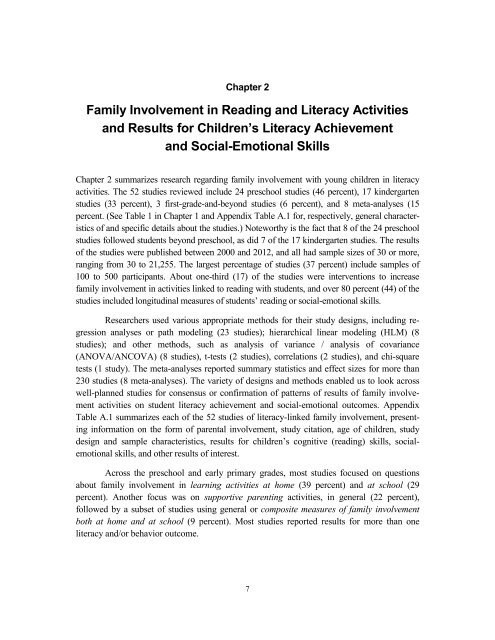u3QtN
u3QtN
u3QtN
You also want an ePaper? Increase the reach of your titles
YUMPU automatically turns print PDFs into web optimized ePapers that Google loves.
Chapter 2<br />
Family Involvement in Reading and Literacy Activities<br />
and Results for Children’s Literacy Achievement<br />
and Social-Emotional Skills<br />
Chapter 2 summarizes research regarding family involvement with young children in literacy<br />
activities. The 52 studies reviewed include 24 preschool studies (46 percent), 17 kindergarten<br />
studies (33 percent), 3 first-grade-and-beyond studies (6 percent), and 8 meta-analyses (15<br />
percent. (See Table 1 in Chapter 1 and Appendix Table A.1 for, respectively, general characteristics<br />
of and specific details about the studies.) Noteworthy is the fact that 8 of the 24 preschool<br />
studies followed students beyond preschool, as did 7 of the 17 kindergarten studies. The results<br />
of the studies were published between 2000 and 2012, and all had sample sizes of 30 or more,<br />
ranging from 30 to 21,255. The largest percentage of studies (37 percent) include samples of<br />
100 to 500 participants. About one-third (17) of the studies were interventions to increase<br />
family involvement in activities linked to reading with students, and over 80 percent (44) of the<br />
studies included longitudinal measures of students’ reading or social-emotional skills.<br />
Researchers used various appropriate methods for their study designs, including regression<br />
analyses or path modeling (23 studies); hierarchical linear modeling (HLM) (8<br />
studies); and other methods, such as analysis of variance / analysis of covariance<br />
(ANOVA/ANCOVA) (8 studies), t-tests (2 studies), correlations (2 studies), and chi-square<br />
tests (1 study). The meta-analyses reported summary statistics and effect sizes for more than<br />
230 studies (8 meta-analyses). The variety of designs and methods enabled us to look across<br />
well-planned studies for consensus or confirmation of patterns of results of family involvement<br />
activities on student literacy achievement and social-emotional outcomes. Appendix<br />
Table A.1 summarizes each of the 52 studies of literacy-linked family involvement, presenting<br />
information on the form of parental involvement, study citation, age of children, study<br />
design and sample characteristics, results for children’s cognitive (reading) skills, socialemotional<br />
skills, and other results of interest.<br />
Across the preschool and early primary grades, most studies focused on questions<br />
about family involvement in learning activities at home (39 percent) and at school (29<br />
percent). Another focus was on supportive parenting activities, in general (22 percent),<br />
followed by a subset of studies using general or composite measures of family involvement<br />
both at home and at school (9 percent). Most studies reported results for more than one<br />
literacy and/or behavior outcome.<br />
7


